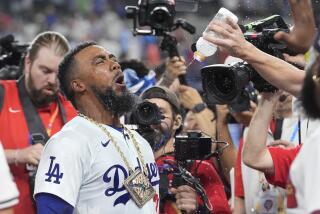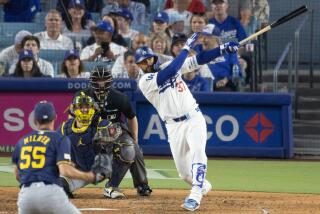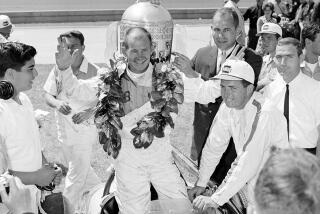Petit Prix
They’re five-ounce handmade cars that do not beep like a Game Boy, flash like a laser or coo like a Furby. Nor are they mere Matchboxes or Hot Wheels. We’re talking Boy Scout Pinewood Derby cars, handmade miniature vehicles that whoosh down plywood tracks in a childhood race tradition that has outlasted soapbox cars.
Since Cubmaster Don Murphy of Pack 280C in Manhattan Beach first helped his son carve a soft pine block into a racing machine in 1953, nearly 50 million Cubs have built and raced cars in derby competitions nationwide. Basics remain the same: each entrant starts with a standard-issue kit of one block of wood, four plastic wheels and four axle nails. Then the work begins.
The cubs whittle their pine blocks into ferocious Bengal tigers, X-wing fighters or hot dogs no more than 7 inches long and 2 3/4 inches wide. Six year olds fresh from a Barney obsession become well-versed in the laws of aerodynamics. Over the hum of a band saw, preteens argue with dads over what constitutes improper graphite application. Dads argue with dads about finishing times separated by 1/1000 of a second. Fuzzy snapshots of creations both crude and confounding are posted on countless Web sites.
This week, for the 48th year running, the Cub Scout Pack that originated the derby will hold it again (on March 16 at Hermosa Valley School in Hermosa Beach, with Boy Scouts of America’s Pacifica District finals to follow at the Del Amo Shopping Center on March 18). Gary McAulay, a Long Beach police officer and a Cubmaster in Manhattan Beach, scoured old record books to find the derby’s dad. “I copied the more unusual names of some of the guys and tracked them down,” says McAulay. “One of the former Cubs said he played golf with Don Murphy, the derby’s founder, and I went looking for him.”
“I could tell he was a cop,” Murphy says of the off-duty officer who showed up at his door. Straightforward questioning quickly established Murphy’s credentials.
“Not only did he have the original rule book, pictures and papers for the event,” McAulay recalls, “he showed me the copyright given to him when he retired.” Derby rules have changed little since Murphy founded it; one was altered to shorten the maximum length of a car from 7 3/ 8 inches to 7. It would be easier to amend the U.S. Constitution.
Murphy left Scouting in 1978 but gave permission for the derby to continue. “It came as quite a surprise to learn from Gary how much it had grown all around the world,” he says modestly.
Indeed. McAulay, recently surfing the more than 1,000 derby-themed Web sites, noted an online bidder who paid $36 for 52 old-style derby car wheels. “Original derby car kits had balloon tires like Indy racers,” McAulay says. In the ‘70s, “the kits became more like Formula 1 cars and tires got wider.” When the bidder looked for his old cars, most of the wheels were gone. “He paid big bucks for a small bucket of little classics.”
“In derby races, the first, second and third car to cross the finish line win awards, as does “Best Design.” In certain troops, every child goes home with some kind of award, such as “Best Use of Glitter” or “Shiniest.”
*
* The chorus to the U.S. Scouting Service Project’s official Pinewood Derby Song, sung to the tune of “De Camptown Races”:
Going to run so fast,
Going to get ahead,
Bet my money on a blue pine car,
Somebody bet on the red.
*
* Red is the favored pinewood car color.
* Each year more than 1 million kits, at $2.50-$4, are sold in the United States.
* The “Pinewood Fun Facts Web site” asks: “Did you know that 5 ounces, the maximum Pinewood Derby car weight, is equal to about 56 new copper-clad U.S. pennies?”
--Pardis Mahdavi
*
Don Murphy
Retired Art Director
Founder of the Pinewood Derby
Car Talk: “The Soapbox Derby started it all. My son Donn was too young to be in it, and I got the idea for a race he and other Cubs could enter. I’d made model airplanes, cars and boats and remembered the pleasure I got out of it. I also wanted to devise a wholesome, constructive activity that would foster a closer father-son relationship and promote good sportsmanship through competition.”
*
Edward Rambo
Printer, L.A. Valley College
Cub Scout in original Pack
His Day At The Races: “I remember the weigh-in because they had a kind of balance scale, and the counterweight for the car was an ink bottle. Some of the cars jumped the track, and it happened to my buddy and me. Both of ours did not make it to the pillow stop at the bottom of the ramp. We were sure the track was at fault, not our cars.”
*
Gary McCulay
Police Officer
Cubmaster, Manhattan Beach
Car Talk: “I have clear memories of working with my dad in 1963
on my first car. I’m also fortunate enough to have had the same pleasure working with my two sons. It’s just a block of wood, but for a kid it’s a lot of work. I value it not so much for the accomplishment, but rather for the unique time spent with my father and then my sons.”
*
Bruce Waters
Configuration Manager, Torrance
Cub Scout in original Pack
His Day At The Races: “I have no memories of the race itself. That’s funny, because when Gary found me, he said I had won my heat! My dad said we used graphite for lubrication, but in looking over the original copy of the rules, we found that we shouldn’t have.
I’m probably going to get stripped of my title!”


